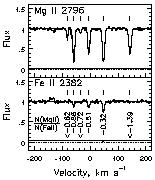


3.2. Photoionization Models
Consider a cloud of material, modeled by a plane parallel
slab with a certain total column density of Hydrogen,
N(H) = N(HI) + N(H II), and with a constant
total number density nH = n(H I) + n(H
II) along the line of sight.
The cloud is also characterized by its metallicity,
Z, which is the ratio of Fe/H expressed
relative to the solar value,
Z , and
by an abundance pattern (the abundance ratios
of all other elements to Fe).
The degree of ionization in the gas depends upon the
intensity and shape of the spectrum of ionizing
radiation.
The intensity is characterized by the ionization
parameter, U = n
, and
by an abundance pattern (the abundance ratios
of all other elements to Fe).
The degree of ionization in the gas depends upon the
intensity and shape of the spectrum of ionizing
radiation.
The intensity is characterized by the ionization
parameter, U = n / nH, which is the
ratio of the number density of photons at the
Lyman edge to the number density of Hydrogen
(nH = ne, where ne
is the total number density of electrons).
The larger the value of U, the more ionized the gas.
Collisional ionization can also be an important
process for some absorption systems with gas
at high temperatures (hundreds of thousands of degrees).
Photoionization equilibrium models typically yield
temperatures of tens of thousands of degrees.
/ nH, which is the
ratio of the number density of photons at the
Lyman edge to the number density of Hydrogen
(nH = ne, where ne
is the total number density of electrons).
The larger the value of U, the more ionized the gas.
Collisional ionization can also be an important
process for some absorption systems with gas
at high temperatures (hundreds of thousands of degrees).
Photoionization equilibrium models typically yield
temperatures of tens of thousands of degrees.
Once the metallicity, abundance pattern, ionization parameter, and spectral shape are specified the equations of radiative transfer can be solved to find the column densities of all the different ionization states of various chemical elements. Figure 6 illustrates, for N(HI) = 1016 and 1019 cm-2, the dependence of column densities of various transitions on the ionization parameter, U. For optically thin gas [N(HI) < 1017.2 cm-2], the column density ratios of the various metal transitions are not dependent on the overall metallicity, i.e. the curves shift vertically in proportion to Z. For optically thick gas, ionization structure develops, with an outer ionized layer around a neutral core, and there is no simple scaling relation with metallicity.
In practice, if we assume that a cloud has a simple,
single phase structure, the ratios of the column
densities can be used to infer the ionization parameter,
which relates to the density of the gas.
However, the abundance pattern can differ from the solar
abundance pattern because of differing degrees of
depletion onto dust, or because of different processing histories.
Most of the so-called  particle
nuclei (such as Mg and Si) are synthesized primarily by
Type II supernovae during the early history
of a galaxy when most massive stars form and quickly
evolve to reach their end states.
On the other hand, the Fe-group elements are primarily
produced by Type Ia supernovae, and therefore build up
over a longer timescale.
In the basic picture of galaxy evolution, the halo stars
are formed early, have been enriched only by Type II
supernova, and therefore are
particle
nuclei (such as Mg and Si) are synthesized primarily by
Type II supernovae during the early history
of a galaxy when most massive stars form and quickly
evolve to reach their end states.
On the other hand, the Fe-group elements are primarily
produced by Type Ia supernovae, and therefore build up
over a longer timescale.
In the basic picture of galaxy evolution, the halo stars
are formed early, have been enriched only by Type II
supernova, and therefore are
 -element enhanced.
Younger disk stars have incorporated also the Type Ia
processed material and therefore have relatively larger
Fe-group abundances.
Ideally, several different ionization states of
the same chemical element are observed so that
there is no ambiguity between the ionization
parameter and the abundance pattern, but this
has generally not yet been possible because of limited
wavelength coverage at high resolution.
-element enhanced.
Younger disk stars have incorporated also the Type Ia
processed material and therefore have relatively larger
Fe-group abundances.
Ideally, several different ionization states of
the same chemical element are observed so that
there is no ambiguity between the ionization
parameter and the abundance pattern, but this
has generally not yet been possible because of limited
wavelength coverage at high resolution.

|
Figure 7. HIRES/Keck Fe II and Mg II absorption profiles for the z = 1.325 system in the spectrum of the quasar Q0117+213. The six clouds in this system show a range of more than an order of magnitude in N(Fe II) / N(Mg II), given below each cloud in the lower panel. These variations could be due to cloud to cloud variations of ionization parameter (density) or of abundance pattern within the system. |
Examples of the variation of column density ratios with velocity in two absorption systems are shown in Figures 7 and 8. In Figure 7, N(Fe II) / N(Mg II) varies by an order of magnitude over the four components in the z = 1.325 system toward the quasar Q0117+213. This represents a variation of an order of magnitude in the ionization parameter (10-4 < U < 10-3), or an order of magnitude variation in the abundance pattern. Figure 8 is a very unusual system with two clouds separated by only 20 km s-1 in velocity, one of which has a Silicon to Aluminum ratio similar to the Milky Way ISM, and the other which requires a significant enhancement of Aluminum.